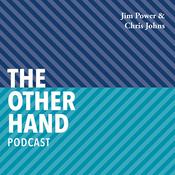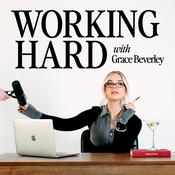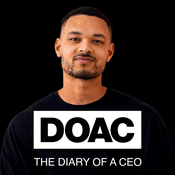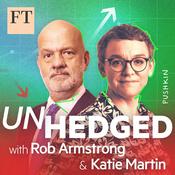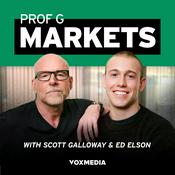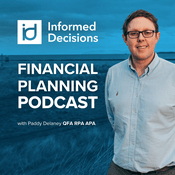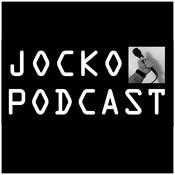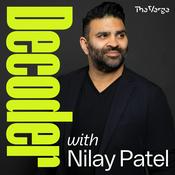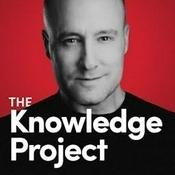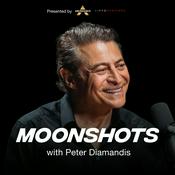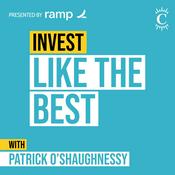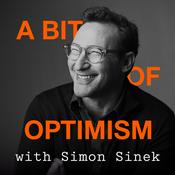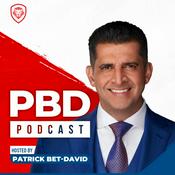Available Episodes
5 of 148
- Family Businesses and the War for Talent | Andreas von Specht, CEO AvS AdvisorsSend us a textFamily businesses represent a significant majority of the European, Asian and US landscape. Yet so much that we focus on in business, governance, and search is designed for corporates.In this podcast, Dr Sabine Dembkowski, Founder and Managing Partner of Better Boards, is joined by Andreas von Specht. Andreas von Specht is a family shareholder and NED of Berenberg Bank, Europe’s second-oldest private bank, and shareholder of Bergos Bank in Zurich. He founded AvS Advisors in 2011 to advise privately held clients on succession and family governance. Previously, he built a career in Consumer Goods and was a long-time partner at Egon Zehnder in Germany and France.“30 years ago, it was very much based on a ‘nose factor’ kind of selection, and it has become a really well thought-through search process.“Andreas' upbringing in a family business gives him special insight into the culture, thought patterns, and habits of family businesses. He can draw a line from pre-Internet ‘nose factor’ talent searches to the current professionalised systems. While the unique nuances of strong family shareholder groups and cultural fit factors are the trump card, competency testing, benchmarking, and sophisticated evaluations are now in play.“There is one competency that is a little bit difficult to describe, which I would call a special ability to operate in a family business.” Succeeding in a family business environment is possible, even if one comes from the corporate world. Andreas believes it requires high emotional intelligence (EQ) and a moderate ego.Successful candidates must be able to bring family members along on the business journey while preserving relationships. Humility, a sense of humour, and adaptability must overlay real business acumen and competency, as families will ask if the executive or board candidate brings particularly valuable or missing skills to the business.“Results and values move together, so performance sits alongside legacy and family expectations.”Within a family business, governance always has more layers, with owners, the board, a family council, and the next generation all in the mix. Leaders must agree on what short-term and long-term really mean for the business, and the same goes for change initiatives. He recommends a clear change contract at the beginning to avoid misunderstandings.“It takes two to tango… we are in the midst of a fierce war for talent, and that must be taken into consideration.”For families, there is a ‘search before the search’ to select a search partner that understands their needs and the family culture. Trust is critical. It is also critical to have clear expectations and alignments of what they're really looking for and what good looks like.Families must also remember it takes two. Quality, independent candidates for executive roles and board positions will have choices. Families just can’t pick the best candidate to serve at their leisure. Instead, there is a certain degree of selling required to get to know each other and build trust. The three top takeaways from our conversation are:1. Fit and clarity regarding the role and requirements must come first.2. Cultural fit often decides the outcome. 3. Professionalise the whole journey so that the hiring process leads to a successful, loIf you would like to become part of the Better Boards community, learn about our distinctive approach and explore opportunities to work with us or contribute to The Better Boards podcast series, get in touch at [email protected]. We love to hear from you.--------24:47
- Board Governance Considerations in Private Market Investments | Dr Eelco Fiole, CFO, NEDSend us a textPrivate equity, private debt – private markets are absolutely the flavour of the day. Yet, despite the headlines and eye-catching numbers, very little discussion is taking place about governance in this context. In this podcast, Dr Sabine Dembkowski, Founder and Managing Partner, is joined by Dr Eelco Fiole. He has more than 30 years of international finance experience, including two decades as Non-Executive Director, CFO, and CEO in alternative investments with teams in Zurich, London, New York, and Singapore. He also holds more than eight advanced degrees and is a true polymath with special expertise in investment governance.“Private market investing comes with a lot of issues.“Eelco reports that over the next five years, private markets are expected to double to $30 trillion USD. Private investors now invest alongside traditional institutions. Yet serious issues remain, including complex structures, valuation challenges, opacity, layers of leverage, and enormous asymmetries of information. “Governance is work, and when that work is being done, trust also develops.”To Eelco, governance is a key factor in creating trust for LPs and GPs. Both must contribute to building a solid governance framework. For LPs, remember that greed is not a strategy. Instead, use governance structures as a filtering tool to address issues of valuation, transparency, and conflicts of interest. For GPs, good governance helps attract capital. Eelco noticed that the smartest GPs use well-structured governance agreements to differentiate themselves, back up big promises, and showcase how they plan to protect investors. “It’s all about incentives.“In Eelco’s experience, many trust-based issues can be resolved by examining the incentives at play. Who is getting paid, when are they being paid, and how are those payments structured? Following the money and understanding who benefits in various scenarios is key to effective governance. On a practical level, this means building desired behaviours into the documentation. “Every investment is situational.“Eelco feels every investment has its own unique characteristics. As a result, “off the shelf” legal documents may not be sufficient. Custom-crafted or heavily adapted documents that cover the legal and economic variations of the investment, investment team, and market are key. The same is true for individuals who want a seat at the table. Private markets are highly specialised and nuanced. Only individuals who can add value in specific ways will be welcomed. “If I cannot have proper representation of the interest, then I'm not going to do it.” Eelco sees many cases where things go wrong, where highly concentrated investors are excluded, or where LP committees have no power. He is not calling for regulators to step in, but for boards to thoughtfully use governance structures to create checks and balances.The three top takeaways from our conversation for effective boards are:1. Governance is work.2. For GPs, understand the mechanics of trust and its role in attracting capital. 3. Standard legal documentation is not enough. You must build in your own situationally appropriate models into the agreements.Join The Better Boards Community - info@bIf you would like to become part of the Better Boards community, learn about our distinctive approach and explore opportunities to work with us or contribute to The Better Boards podcast series, get in touch at [email protected]. We love to hear from you.--------21:12
- Managing risks in highly regulated industries | Terri Duhon, Chair of Risk CommitteesSend us a textThe breadth, depth, and frequency of risks have increased tremendously. Serving on risk committees is particularly challenging at present, making it important to take a fresh look at the risks, risk mitigation, regulatory scrutiny, and stakeholder complexities the risk committee must balance. In this podcast, Dr Sabine Dembkowski, Founder and Managing Partner, is joined by Terri Duhon. Terri is an award-winning educator and TEDx speaker. She went from earning a master's degree at MIT to becoming a derivatives trader on Wall Street, and then an entrepreneur and author. Terri serves as a board member at Morgan Stanley, Wise, and Rathbone Brothers. She is also a guest lecturer at the LSE and Oxford University, where she's an Associate Fellow for the Saïd Business School. “I split the world between financial risks and non-financial risks.”Terri sees the risk committee as working for the Board, even as the Board ultimately retains ownership of strategy and risk management. Within that work, she distinguishes between financial and non-financial risks.Financial risks are a comfortable space for her, thanks to her background in trading and the cutting-edge approach to viewing risk she learned at JPMorgan. Yet non-financial risks – operational, cyber, regulatory, change, and so on – are an increasing part of the work in regulated fields. The non-financial risks are harder to quantify and require significant thought and engagement across different business lines to work through.“As a chair, I say, ‘What are the big things I have to focus on today? ’”Every company will have a big, long list of risks. For Terri, the real value of the risk committee is to narrow the focus to the big three or five things. As Terri notes, on the risk committee, you don’t have infinite time or infinite resources. In four to five hours a quarter, what are the most critical topics and challenges? Pushing for thoughtful consideration and risk weighing is a big part of how the risk committee supports and works for the Board. “We can either skim 1000 pages, or we can really think about 50 pages.”Terri knows Boards face mountains of information. Quality discussions come down to ruthlessness around focus. Boards skimming tons of material are less valuable than Boards focused on the company's most significant challenges. “We challenge the robustness of the process, as opposed to challenging the decision itself or challenging the output.”To Terri, quality in a risk committee means probing the processes and robustness of the discussions and decisions. Offering this challenge helps drive deeper discussion and prepares CROs for good conversations with regulators about how they are challenged by their risk partners. Plus, having Boards explain the rationale for decisions provides more space for high-quality deliberation on action plans, risk ratings, and accountability, so that all key stakeholders fully support final choices. The three top takeaways from our conversation for more effective boards are:1. The job of Board members is to challenge and oversee, asking for thoughtfulness on papers and accountability on actions.2. It is essential to manage the energy in risk meetings to ensure the most critical items are covered first.3. While the risk committee takes work, it can also be quite fun.If you would like to become part of the Better Boards community, learn about our distinctive approach and explore opportunities to work with us or contribute to The Better Boards podcast series, get in touch at [email protected]. We love to hear from you.--------24:29
- It’s not if, its when: the strategic role of Boards in the cyber-risk age | Beatrice Devillon-Cohen, Senior Independent Director and Chair of Risk CommitteesSend us a textCybersecurity is a core business risk that can impact the entire organisation. Boards are challenged to understand how cyber threats impact financial performance, reputation, and regulatory obligations. Boards need to build awareness of their organisation’s cyber security posture, protection measures, and incident response protocols. In this podcast, Dr Sabine Dembkowski, Founder and Managing Partner of Better Boards, is joined by Beatrice Devillon-Cohen. Beatrice has over 25 years of investment banking experience, having led traders’ teams across the UK, Europe, Asia, and the US. She has now developed a portfolio of non-executive positions, having recently served on the Audit Committee of the European Investment Bank and the Finance Committee at King’s College, London. “The Rule of Three is important when it comes to cybersecurity.”As Boards seek to manage and survive cyber threats, the Rule of Three comes into play. On average, in a cyber event, there are three days of chaos, three weeks of systems rebuilding, and three months of constant IT problems. “What has been changing over time is the cyber-criminal groups. They are now running their operation as a business, selling cyber attacks as a service.”The criminal ecosystem has gone professional. While there will always be bored teenagers or disgruntled employees, the more serious players run their operations like business ventures. They sell cyberattacks as a service, backed by deep resources, skilled talent, and vast networks.“You need to work on mitigation, responding to an attack, and recovering. That's your battleground.” While cyber threats can’t be entirely avoided, Beatrice counsels Boards not to despair. There is plenty that can be done. It begins by understanding how threats work.A primary attack path is through links in emails. One-click installs malware that hackers can use for access. Caution and education can help prevent this.Another primary attack path is third-party providers. External suppliers are compromised and used as a bridge into your own internal system. “Never hope for the best when it comes to cybersecurity, because hope will not be a strategy.”Boards are accountable for cyber risk oversight (see the UK Cyber Governance Code of Practice). They need to make it a strategic priority. Build relationships with IT heads, show curiosity, and build trust. Get a strong dialogue going. Educate within the organisation and with third-party partners. Create a no-blame culture so that if something happens, it is escalated immediately, which can limit its impact.“It's our own duty to upskill, stay current, and think around the corner on that subject, like any other subject in the boardroom.”Cyber culture starts at the top. It is not “too complicated” to pick up basic cyber safety skills or understand risk. Plus, with AI and quantum computing on the horizon, any actions Boards can take—and lead their companies to take—will help prepare for future risks.The three top takeaways from our conversation for effective boards are:1. Cyber risk is a business risk. Own it as such. 2. Don't hide, as a Board member, behind “it's too technical and not for me”. Upskill, be curious, and engage with executives.3. Prepare for it. Run exercises and test regulIf you would like to become part of the Better Boards community, learn about our distinctive approach and explore opportunities to work with us or contribute to The Better Boards podcast series, get in touch at [email protected]. We love to hear from you.--------23:46
- Governance Experts as Non-Executive Directors: A perfect fit? | Lyn Colloff, Company SecretarySend us a textGovernance experts and Company Secretaries offer a prime, yet often overlooked, talent pool for high-quality Non-Executive Directors. But what makes them excel on Boards?In this podcast, Dr Sabine Dembkowski, Founder and Managing Partner, speaks with Lyn Colloff, a Fellow of the Chartered Governance Institute with 40 years’ experience in governance, risk, and compliance across listed and regulated sectors. Most recently, she served as Company Secretary and Head of Governance, Risk, and Compliance at Wincanton plc—a FTSE 250 supply chain leader and Executive Team member. Now, she runs her own consultancy, providing governance training and board support, and seeks Non-Executive Director roles.“These individuals are used to exercising independent judgment, which is an important concept for a Non-Executive Director.”Lyn believes Company Secretaries excel as Non-Executives because of their experience and discernment. They bring governance, strategy, and risk expertise, as well as deep insight into boardroom dynamics. Their knowledge of codes, frameworks, and regulations allows them to translate complexity into actionable advice and inform strategic planning.“There’s a case for making sure you’ve got all the skill sets you need in the boardroom, including that big governance piece.”While Lyn acknowledges that CFOs and CEOs dominate Non-Executive roles, she sees opportunities for others. In smaller FTSE, charity, and sport groups that might not have their own Company Secretary, appointing Company Secretaries as Non-Executives helps bring governance expertise to the boardroom.“If you fill the boardroom with just CEOs or ex-CEOs and CFOs, you’re not getting diversity of thought.”As people work longer or shift to a give-back mentality, many want a seat at the table. Lyn asserts that Board Chairs must ensure diverse backgrounds and experiences to achieve a healthy, functioning board.“I don’t accept that Company Secretaries lack financial experience.”Boards often seek P&L backgrounds, but Lyn maintains that Company Secretaries with executive roles possess budgetary acumen and advise remuneration committees. Their financial understanding often spans the whole organisation, not just a single division.“Many in the COSEC space deeply understand how to safeguard shareholder and stakeholder interests.”What sets Company Secretaries apart is their record in strategic planning, transformation, and aligning stakeholders. They’re tuned into the strategic process, understand sector and political environments, and use this knowledge to inform future planning. Board Chairs should carefully identify gaps in the Board’s views and background, and consider whether a Company Secretary could address them.Three key takeaways for effective boards:1. Be open-minded about the skill sets that governance professionals and Company Secretaries bring to the boardroom.2. Consider all Board members’ skills and fill gaps with versatile contributors.3. Identify the risk horizon and understand what’s likely to impact strategy in the coming years, ensuring the Board can address these challenges.Join The Better Boards CommunityWe’d love to connect! To join our community, discover our approach, or share your ideas on The Better Boards Podcast, contact us at [email protected] you would like to become part of the Better Boards community, learn about our distinctive approach and explore opportunities to work with us or contribute to The Better Boards podcast series, get in touch at [email protected]. We love to hear from you.--------18:01
More Business podcasts
Trending Business podcasts
About The Better Boards Podcast Series
The Better Boards podcast series is the podcast for Chairs, CEOs, Non-Executive Directors, Company Secretaries, and their advisors. Every episode is filled with practical insights and learnings from those inside the boardrooms. We tease out what really matters and highlight actionable steps you can take to enhance the performance of your board.
Podcast websiteListen to The Better Boards Podcast Series, The Other Hand and many other podcasts from around the world with the radio.net app
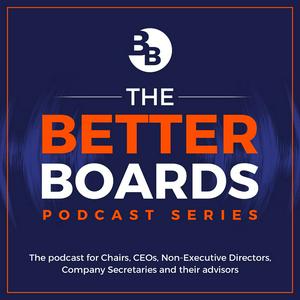
Get the free radio.net app
- Stations and podcasts to bookmark
- Stream via Wi-Fi or Bluetooth
- Supports Carplay & Android Auto
- Many other app features
Get the free radio.net app
- Stations and podcasts to bookmark
- Stream via Wi-Fi or Bluetooth
- Supports Carplay & Android Auto
- Many other app features


The Better Boards Podcast Series
Scan code,
download the app,
start listening.
download the app,
start listening.
